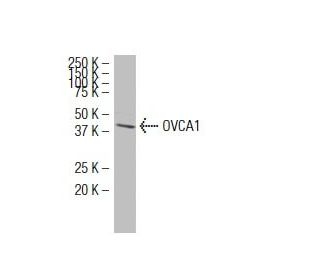


OVCA1 Antibody (6E93): sc-101248
- OVCA1 Antibody (6E93) is a mouse monoclonal IgG2b κ OVCA1 antibody provided at 100 µg/ml
- raised against recombinant OVCA1 of human origin
- recommended for detection of OVCA1 of human origin by WB, IP, IF and ELISA
- At present, we have not yet completed the identification of the preferred secondary detection reagent(s) for OVCA1 Antibody (6E93). This work is in progress.
QUICK LINKS
OVCA1 Antibody (6E93) is a mouse monoclonal IgG2b kappa light chain antibody that detects OVCA1 protein of human origin by western blotting (WB), immunoprecipitation (IP), immunofluorescence (IF), and enzyme-linked immunosorbent assay (ELISA). OVCA1 (6E93) antibody is available as a non-conjugated format. OVCA1, also known as ovarian cancer-associated gene 1 protein, plays a crucial role in the synthesis of diphthamide, a modified histidine amino acid essential for eukaryotic elongation factor 2 (EF-2) function. This post-translational modification is vital because diphthamide serves as the target for ADP-ribosylation by diphtheria toxin, which inactivates EF-2 and disrupts protein synthesis. The diphthamide modification is conserved across all eukaryotes and archaebacteria, and its synthesis involves the coordinated action of five proteins (Dph1-5) and an amidating enzyme, with OVCA1 (Dph-1) being required for the initial step. The chromosomal region containing OVCA1, located at 17p13.3, is frequently deleted in human ovarian carcinoma, indicating that this 15 kb region may harbor a tumor suppressor gene. OVCA1 functions as a tumor suppressor in various cancers, including lung and breast cancers, and OVCA1 overexpression has been shown to inhibit colony formation and reduce ovarian cancer cell growth rate. OVCA1 is expressed in multiple tissues, including heart, brain, placenta, lung, liver, skeletal muscle, kidney, pancreas, spleen, thymus, mammary gland, colon, small intestine, testis, and ovary, highlighting its importance in both normal physiology and cancer biology.
Alexa Fluor® is a trademark of Molecular Probes Inc., OR., USA
LI-COR® and Odyssey® are registered trademarks of LI-COR Biosciences
OVCA1 Antibody (6E93) References:
- Identification and structural analysis of human RBM8A and RBM8B: two highly conserved RNA-binding motif proteins that interact with OVCA1, a candidate tumor suppressor. | Salicioni, AM., et al. 2000. Genomics. 69: 54-62. PMID: 11013075
- OVCA1: emerging as a bona fide tumor suppressor. | Jensen, MR. and Helin, K. 2004. Genes Dev. 18: 245-8. PMID: 14871925
- Gene trap mutagenesis-based forward genetic approach reveals that the tumor suppressor OVCA1 is a component of the biosynthetic pathway of diphthamide on elongation factor 2. | Nobukuni, Y., et al. 2005. J Biol Chem. 280: 10572-7. PMID: 15637051
- OVCA1: tumor suppressor gene. | Chen, CM. and Behringer, RR. 2005. Curr Opin Genet Dev. 15: 49-54. PMID: 15661533
- White spot syndrome virus open reading frame 222 encodes a viral E3 ligase and mediates degradation of a host tumor suppressor via ubiquitination. | He, F., et al. 2006. J Virol. 80: 3884-92. PMID: 16571805
- Translation elongation factor 2 anticodon mimicry domain mutants affect fidelity and diphtheria toxin resistance. | Ortiz, PA., et al. 2006. J Biol Chem. 281: 32639-48. PMID: 16950777
- A cDNA from the ovarian cancer critical region of deletion on chromosome 17p13.3. | Phillips, NJ., et al. 1996. Cancer Lett. 102: 85-90. PMID: 8603384
- Identification of two candidate tumor suppressor genes on chromosome 17p13.3. | Schultz, DC., et al. 1996. Cancer Res. 56: 1997-2002. PMID: 8616839
Ordering Information
| Product Name | Catalog # | UNIT | Price | Qty | FAVORITES | |
OVCA1 Antibody (6E93) | sc-101248 | 100 µg/ml | $333.00 |
